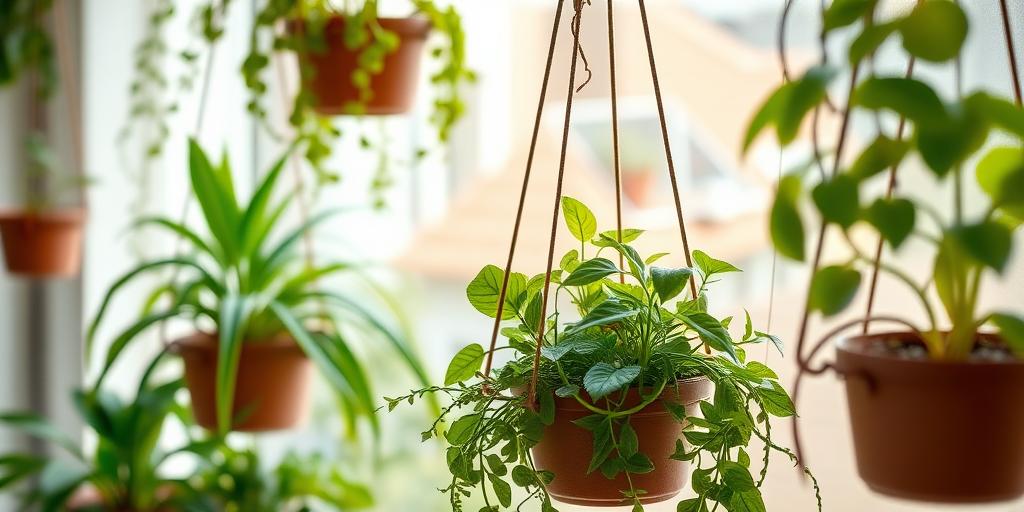
Low-Light, Easy-Care Hanging Plants: Your Ultimate Guide
Discover the best low-light, easy-care hanging plants to brighten up any space! Perfect for beginners and busy plant lovers—learn care tips, top picks, and styling ideas.
Introduction
Did you know that some of the most beautiful houseplants thrive in low light and require minimal care? Whether you’re a busy plant parent or a beginner looking to add greenery to dim corners, this guide is for you! Hanging plants not only save space but also bring life to any room—even those with little natural light. From the resilient Pothos to the elegant Spider Plant, we’ll cover the best low-maintenance options, care tips, and creative ways to display them. Let’s dive in!
Why Choose Low-Light Hanging Plants?
Benefits of Hanging Plants in Small or Dark Spaces
If you live in an apartment with limited floor space or a room that doesn’t get much sunlight, hanging plants are a game-changer. They free up valuable surface area while adding greenery where it might otherwise be impossible. Low-light varieties are especially great because they don’t need bright, direct sun to thrive—just a little ambient light from a window or even artificial lighting.
How Low-Light Plants Improve Indoor Air Quality
Many low-light hanging plants, like spider plants and pothos, are natural air purifiers. They absorb toxins such as formaldehyde and benzene, which can be found in household products and furniture. Even in dimly lit spaces, these plants work hard to keep your air cleaner and fresher.
Perfect for Apartments, Offices, and Rooms with Limited Sunlight
Not everyone has a sun-drenched living room, but that doesn’t mean you can’t enjoy lush greenery. Low-light hanging plants are ideal for north-facing windows, offices with fluorescent lighting, or even bathrooms with just a small frosted window. They bring life to spaces that might otherwise feel dull or sterile.
Top 10 Low-Light, Easy-Care Hanging Plants
Pothos (Epipremnum aureum) – Nearly Indestructible, Fast-Growing
Pothos is the ultimate beginner-friendly plant. It can survive in almost any lighting condition (though it prefers indirect light) and grows quickly, making it perfect for filling up empty corners or cascading from a shelf. Plus, it comes in several stunning varieties, like golden pothos and marble queen.
Spider Plant (Chlorophytum comosum) – Air-Purifying and Pet-Friendly
Spider plants are practically foolproof. They thrive in low to moderate light and produce adorable baby spiderettes that you can propagate. Bonus: they’re non-toxic to pets, so no worries if your cat takes a curious nibble.
Philodendron Heartleaf (Philodendron hederaceum) – Trailing Vines, Low Maintenance
With its heart-shaped leaves and vining habit, this philodendron is a classic. It adapts well to low light and only needs watering when the top inch of soil dries out. A great choice if you want a lush, trailing effect without much effort.
ZZ Plant (Zamioculcas zamiifolia) – Drought-Tolerant, Thrives in Neglect
The ZZ plant is practically bulletproof. It stores water in its rhizomes, meaning it can go weeks without watering. It’s also one of the best plants for extremely low-light conditions, like dim hallways or offices.
Peperomia – Compact and Colorful Varieties
Peperomias come in all sorts of textures and colors, from the watermelon peperomia’s striped leaves to the ripple peperomia’s crinkled foliage. They stay compact, making them ideal for small hanging planters.
String of Hearts (Ceropegia woodii) – Delicate but Hardy
This trailing succulent has dainty heart-shaped leaves and thin vines that look stunning in a hanging pot. It prefers bright, indirect light but can tolerate lower light—just water sparingly to avoid root rot.
English Ivy (Hedera helix) – Classic, Adaptable, and Elegant
English ivy adds a timeless, elegant touch to any space. It grows well in low light and can even help reduce mold in humid areas like bathrooms. Just keep it away from pets, as it’s toxic if ingested.
Cast Iron Plant (Aspidistra elatior) – Extremely Tough, Slow-Growing
True to its name, the cast iron plant can withstand neglect, low light, and even temperature fluctuations. It won’t grow as quickly as some other plants, but its deep green leaves add a sophisticated touch.
Bird’s Nest Fern (Asplenium nidus) – Adds Tropical Vibes
If you love the look of ferns but worry about their finicky reputation, try a bird’s nest fern. It thrives in humidity and low light, making it perfect for bathrooms or kitchens.
Parlor Palm (Chamaedorea elegans) – Lush and Graceful
Parlor palms bring a touch of the tropics to any room. They grow well in low light and can handle occasional neglect, making them a great statement piece in a hanging planter.
Essential Care Tips for Low-Light Hanging Plants
Watering Guidelines (Avoid Overwatering!)
The biggest mistake with low-light plants is overwatering. Since they get less light, they dry out more slowly. Always check the soil before watering—stick your finger in about an inch deep. If it’s dry, it’s time to water; if not, wait a few more days.
Best Soil Types for Drainage and Health
A well-draining potting mix is key to preventing root rot. Look for mixes with perlite or orchid bark to improve aeration. For succulents like string of hearts, a cactus mix works best.
How to Fertilize Without Overfeeding
Low-light plants grow slower, so they don’t need frequent fertilizing. A diluted liquid fertilizer every 2-3 months during the growing season (spring and summer) is usually enough. Skip fertilizing in winter when growth slows.
Pruning and Propagation Tips
Regular pruning keeps plants looking full and healthy. For vining plants like pothos or philodendron, trim back leggy stems to encourage bushier growth. Many of these plants are easy to propagate—just snip a stem with a few leaves and place it in water or soil.
Styling Ideas for Hanging Plants
Macramé Hangers vs. Wall-Mounted Planters
Macramé hangers add a bohemian vibe and work well in living rooms or bedrooms. Wall-mounted planters, on the other hand, are great for saving floor space in small apartments.
Layering Plants at Different Heights for Visual Interest
Hang a mix of trailing and upright plants at varying heights to create a dynamic display. For example, pair a cascading pothos with a fuller bird’s nest fern for contrast.
Best Rooms to Hang Plants (Bathrooms, Kitchens, Hallways)
Bathrooms with high humidity are perfect for ferns and ivy. Kitchens benefit from air-purifying plants like spider plants. Hallways with minimal light? ZZ plants or cast iron plants will thrive there.
Common Problems & Solutions
Yellowing Leaves? Here’s How to Fix It!
Yellow leaves usually mean overwatering or poor drainage. Let the soil dry out completely before watering again, and ensure your pot has drainage holes. If the problem persists, check for root rot.
Dealing with Pests (Spider Mites, Mealybugs)
Spider mites and mealybugs love low-light, stressed plants. Wipe leaves with a damp cloth or use insecticidal soap. For severe infestations, isolate the plant and treat with neem oil.
Signs Your Plant Needs More (or Less) Light
If your plant is stretching toward light or has pale, small leaves, it might need more brightness. On the other hand, scorched or crispy leaves suggest too much direct sun. Adjust placement gradually to avoid shock.
Conclusion
Low-light hanging plants are the perfect solution for adding greenery to any space—no green thumb required! With the right picks and simple care, you can enjoy lush, trailing foliage even in the darkest corners. Ready to transform your home? Start with a Pothos or Spider Plant and watch your indoor jungle thrive!
